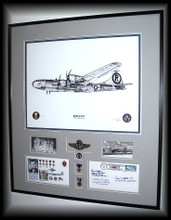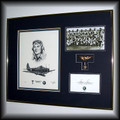 Loading... Please wait...
Loading... Please wait...- Home
- Frmd Collectibles ~ 35% OFF ~ Free Shipping
- Enola Gay by Lon Ortega (autograph by: Gen. Paul Tibbets, Morris Jeppson, Dutch Van Kirk) ~ 35% Off ~ Free Shipping
Product Description
Frame Size: 21" x 24" ----- Commemorative First Day Cover autographed in ink by; Pilot: Gen. Paul W. Tibbets,
Weapons Test Officer: Morris R. Jeppson, Navigator; Theodore "Dutch" Van Kirk. Comes with a COA.
"Enola Gay" by Lon Ortega
Enola Gay and the Hiroshima Mission
On 5 August 1945, during preparation for the first atomic mission, Tibbets assumed command of the aircraft and named it after his mother, Enola Gay Tibbets, who, in turn, had been named for the heroine of a novel. When it came to selecting a name for the plane, Tibbets later recalled that:
... my thoughts turned at this point to my courageous red-haired mother, whose quiet confidence had been a source of strength to me since boyhood, and particularly during the soul-searching period when I decided to give up a medical career to become a military pilot. At a time when Dad had thought I had lost my marbles, she had taken my side and said, "I know you will be all right, son."
The name was painted on the aircraft on 5 August by Allan L. Karl, an enlisted man in the 509th. Regularly-assigned aircraft commander Robert Lewis was unhappy to be displaced by Tibbets for this important mission, and became furious when he arrived at the aircraft on the morning of 6 August to see it painted with the now-famous nose art.
Hiroshima was the primary target of the first nuclear bombing mission on 6 August, with Kokura and Nagasaki as alternative targets. Enola Gay, piloted by Tibbets, took off from North Field, in the Northern Mariana Islands, about six hours' flight time from Japan, accompanied by two other B-29s, The Great Artiste, carrying instrumentation, and a then-nameless aircraft later called Necessary Evil, commanded by Captain George Marquardt, to take photographs. The director of the Manhattan Project, Major General Leslie R. Groves, Jr., wanted the event recorded for posterity, so the takeoff was illuminated by floodlights. When he wanted to taxi, Tibbets leaned out the window to direct the bystanders out of the way. On request, he gave a friendly wave for the cameras.
Hiroshima explosion
After leaving Tinian, the aircraft made their way separately to Iwo Jima, where they rendezvoused at 2,440 meters (8,010 ft) and set course for Japan. The aircraft arrived over the target in clear visibility at 9,855 meters (32,333 ft). Captain William S. "Deak" Parsons of Project Alberta, who was in command of the mission, armed the bomb during the flight to minimize the risks during takeoff. His assistant, Second Lieutenant Morris R. Jeppson, removed the safety devices 30 minutes before reaching the target area.
The release at 08:15 (Hiroshima time) went as planned, and the Little Boy took 53 seconds to fall from the aircraft flying at 31,060 feet (9,470 m) to the predetermined detonation height about 1,968 feet (600 m) above the city. Enola Gay traveled 11.5 mi (18.5 km) before it felt the shock waves from the blast. Although buffeted by the shock, neither Enola Gay nor The Great Artiste was damaged.
The detonation created a blast equivalent to 16 kilotons of TNT (67 TJ). The U-235 weapon was considered very inefficient, with only 1.7% of its fissile material reacting. The radius of total destruction was about one mile (1.6 km), with resulting fires across 4.4 square miles (11 km2). Americans estimated that 4.7 square miles (12 km2) of the city were destroyed. Japanese officials determined that 69% of Hiroshima's buildings were destroyed and another 6–7% damaged. Some 70,000–80,000 people, 30% of the city's population, were killed by the blast and resultant firestorm, and another 70,000 injured. Out of those killed, 20,000 were soldiers and 20,000 Korean slave laborers.
Enola Gay returned safely to its base on Tinian to great fanfare, touching down at 2:58 pm, after 12 hours 13 minutes. The Great Artiste and Necessary Evil followed at short intervals. Several hundred people, including journalists and photographers, had gathered to watch the planes return. Tibbets was the first to disembark, and was presented with the Distinguished Service Cross on the spot.













